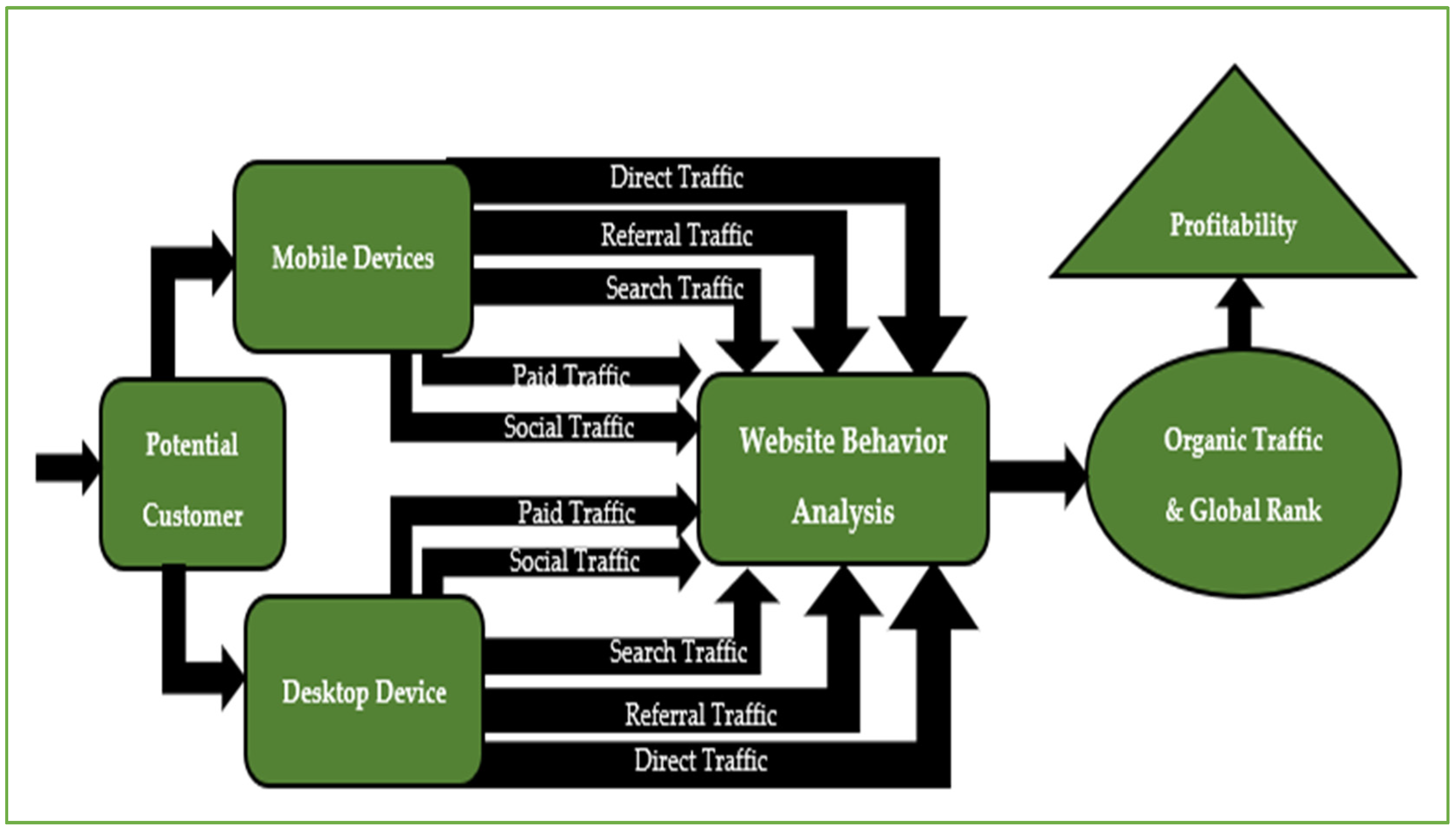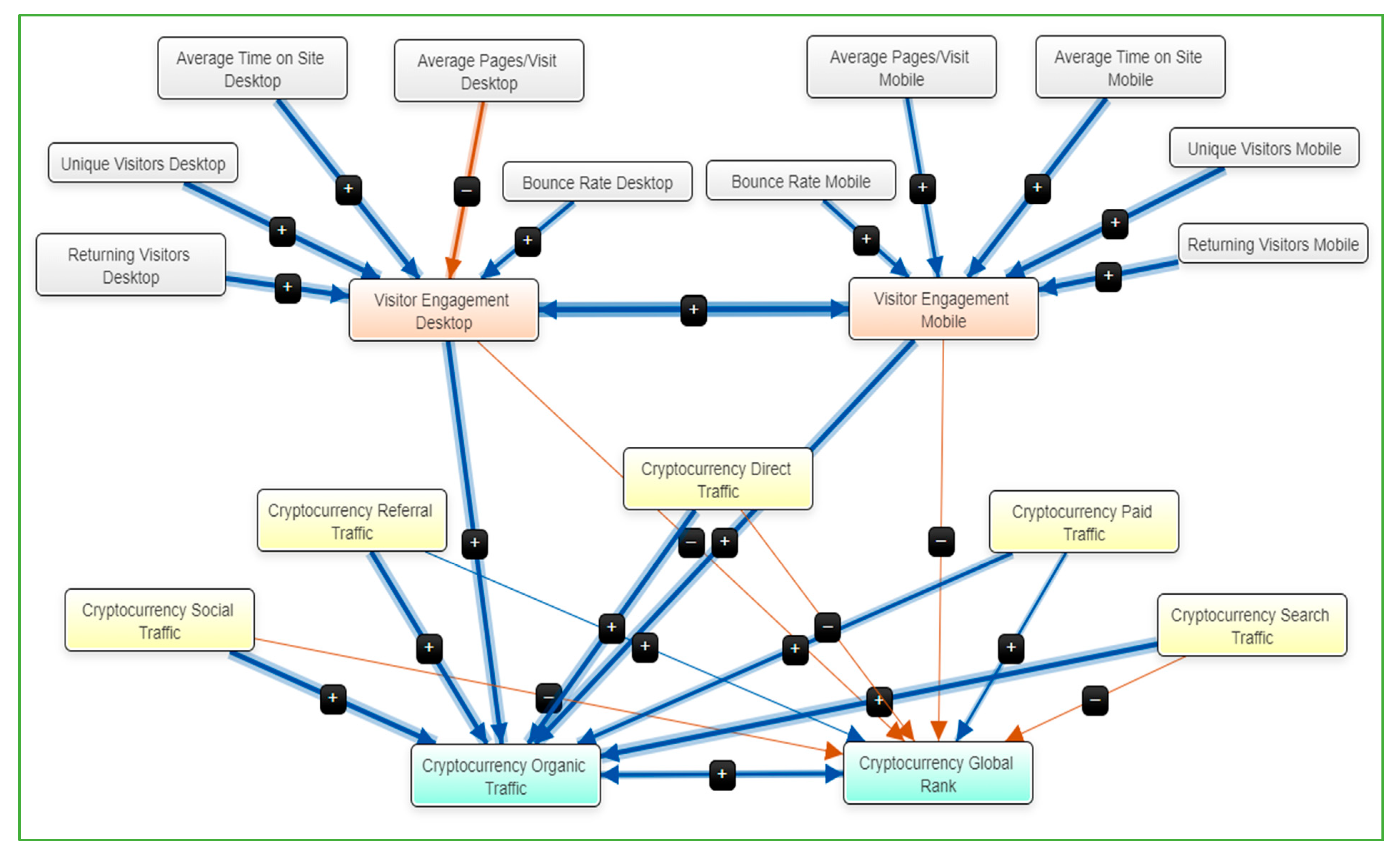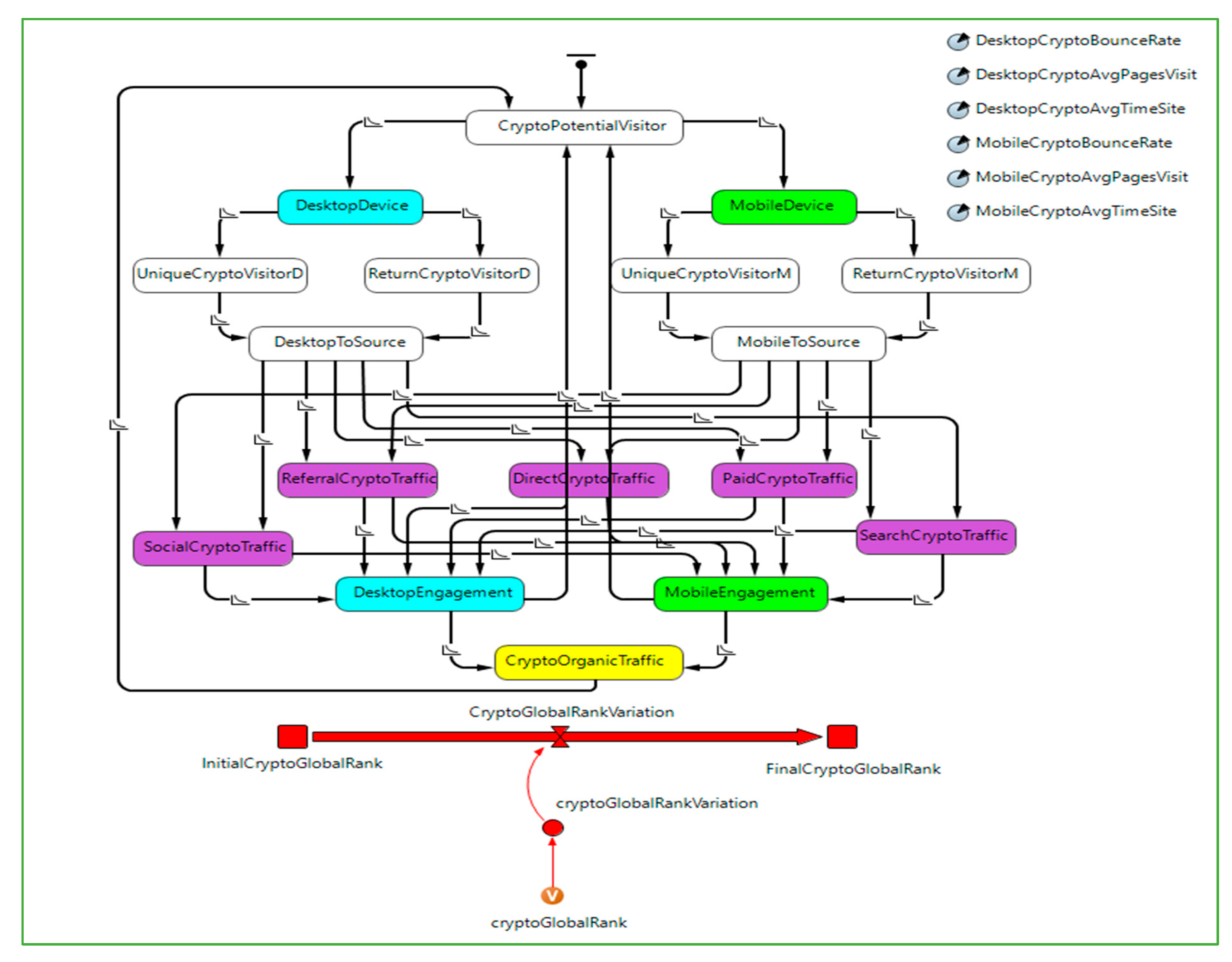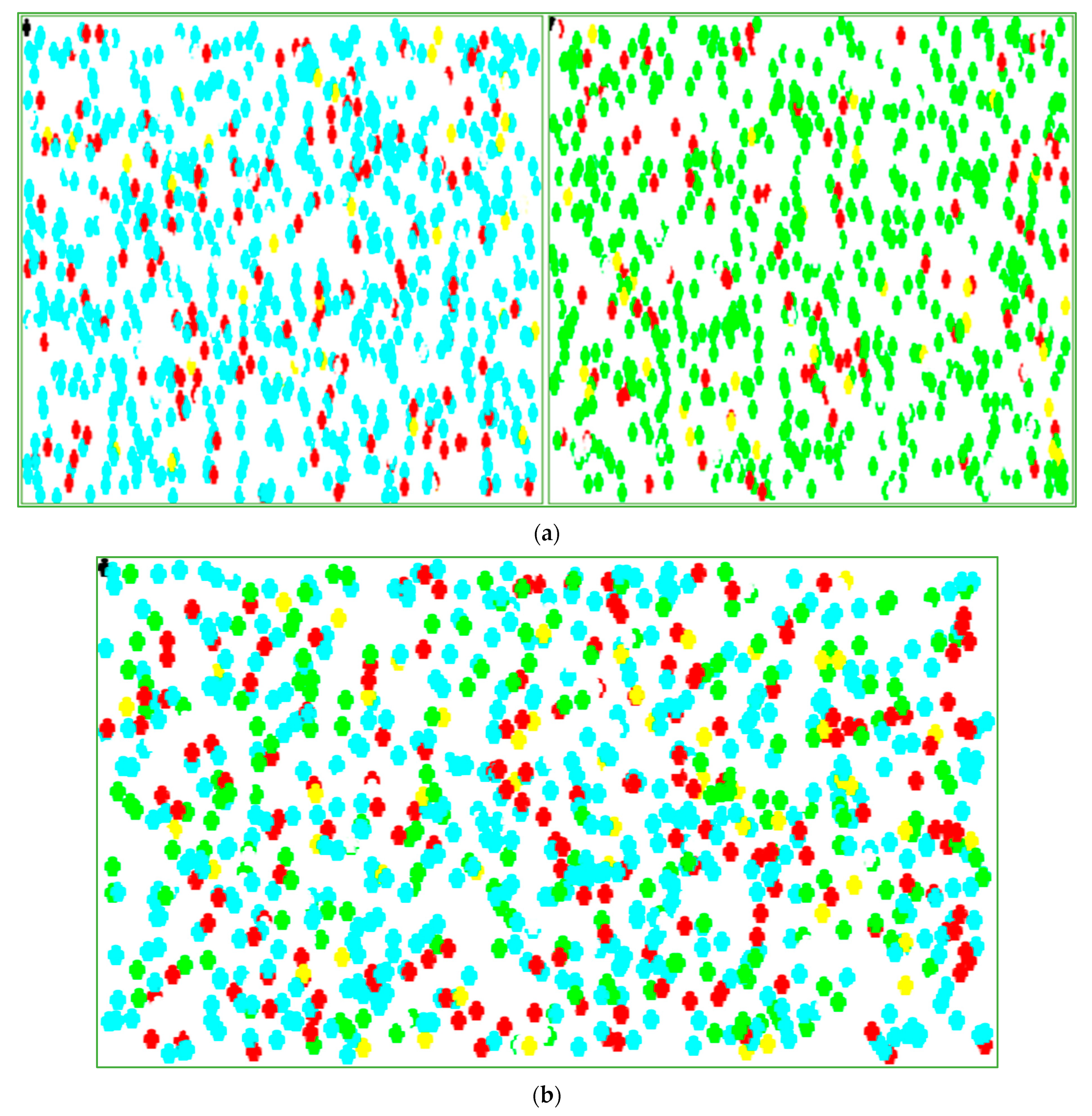Digital Marketing Enhancement of Cryptocurrency Websites through Customer Innovative Data Process
Abstract
1. Introduction
1.1. Digital Marketing of Cryptocurrency Websites
1.1.1. Importance of Customer Engagement and Device Preference in E-Commerce
1.1.2. Digital Promotion and Cryptocurrency Data Analysis
1.2. Decentralized Systems of Payment and Customer Website Visits
1.2.1. Decentralization as an Innovative Strategical Payment Tool
1.2.2. KPIs for Cryptocurrency User Engagement and Website Traffic Sources
1.3. Research Motivations
1.4. Related Literature
1.5. Approach of the Study
1.6. Research Hypotheses
- Cryptocurrency marketers and strategists define organizations’ goals and advancement in the market through evaluating website customer behavior.
- Developers of cryptocurrency websites adjust and upgrade aspects of their cryptocurrency platform operations to attract and engage more customers.
2. Materials and Methods
Sample Selection and Data Availability
3. Results
3.1. Development of Diagnostic and Exploratory Model
3.2. Development of Predictive and Simulation Model
4. Discussion
5. Conclusions
5.1. Conclusions on Cryptocurrency Websites Digital Promotion Based on Device Preference, Customer Engagement, and Traffic Sources
5.2. Research Implications
5.3. Limitations
5.4. Future Work
Author Contributions
Funding
Institutional Review Board Statement
Informed Consent Statement
Data Availability Statement
Conflicts of Interest
Appendix A
| JAVA coding route for defining cryptocurrency organizations’ organic traffic and global rank |
| case CryptoPotentialVisitor://(Simple state (not composite)) statechart.setActiveState_xjal(CryptoPotentialVisitor); { potentialCryptoVisitor++L ;} transition.start(); transition1.start(); return; case DesktopDevice://(Simple state (not composite)) statechart.setActiveState_xjal(DesktopDevice); transition2.start(); transition3.start(); return; case UniqueCryptoVisitorD://(Simple state (not composite)) statechart.setActiveState_xjal(UniqueCryptoVisitorD); { uniqueCryptoDesktopVisitor = potentialCryptoVisitor ;} transition6.start(); return; case DesktopToSource://(Simple state (not composite)) statechart.setActiveState_xjal(DesktopToSource); transition10.start(); transition11.start(); transition12.start(); transition13.start(); transition14.start(); return; case SocialCryptoTraffic://(Simple state (not composite)) statechart.setActiveState_xjal(SocialCryptoTraffic); { cryptoSocialTraffic++ ;} transition15.start(); transition27.start(); return; case DesktopEngagement://(Simple state (not composite)) statechart.setActiveState_xjal(DesktopEngagement); { desktopEngagement = (1-DesktopCryptoBounceRate) + DesktopCryptoAvgPagesVisit + DesktopCryptoAvgTimeSite + uniqueCryptoDesktopVisitor + returnCryptoDesktopVisitor ;} transition25.start(); transition32.start(); return; case CryptoOrganicTraffic://(Simple state (not composite)) statechart.setActiveState_xjal(CryptoOrganicTraffic); { cryptoGlobalRank = cryptoGlobalRankMobile + cryptoGlobalRankDesktop; cryptoOrganicTraffic = cryptoOrganicTrafficDesktop + cryptoOrganicTrafficMobile ;} transition34.start(); return; case MobileEngagement://(Simple state (not composite)) statechart.setActiveState_xjal(MobileEngagement); { mobileEngagement = (1-MobileCryptoBounceRate) + MobileCryptoAvgPagesVisit + MobileCryptoAvgTimeSite + returnCryptoMobileVisitor + uniqueCryptoMobileVisitor ;} transition26.start(); transition33.start(); return; case ReferralCryptoTraffic://(Simple state (not composite)) statechart.setActiveState_xjal(ReferralCryptoTraffic); { cryptoReferralTraffic++ ;} transition16.start(); transition31.start(); return; case SearchCryptoTraffic://(Simple state (not composite)) statechart.setActiveState_xjal(SearchCryptoTraffic); { cryptoSearchTraffic++ ;} transition18.start(); transition28.start(); return; case PaidCryptoTraffic://(Simple state (not composite)) statechart.setActiveState_xjal(PaidCryptoTraffic); { cryptoPaidTraffic++ ;} transition19.start(); transition29.start(); return; case DirectCryptoTraffic://(Simple state (not composite)) statechart.setActiveState_xjal(DirectCryptoTraffic); { cryptoDirectTraffic++ ;} transition17.start(); transition30.start(); return; case ReturnCryptoVisitorD://(Simple state (not composite)) statechart.setActiveState_xjal(ReturnCryptoVisitorD); { returnCryptoDesktopVisitor = potentialCryptoVisitor ;} transition7.start(); return; case MobileDevice://(Simple state (not composite)) statechart.setActiveState_xjal(MobileDevice); transition4.start(); transition5.start(); return; case UniqueCryptoVisitorM://(Simple state (not composite)) statechart.setActiveState_xjal(UniqueCryptoVisitorM); { uniqueCryptoMobileVisitor = potentialCryptoVisitor ;} transition8.start(); return; case MobileToSource://(Simple state (not composite)) statechart.setActiveState_xjal(MobileToSource); transition20.start(); transition21.start(); transition22.start(); transition23.start(); transition24.start(); return; case ReturnCryptoVisitorM://(Simple state (not composite)) statechart.setActiveState_xjal(ReturnCryptoVisitorM); { returnCryptoMobileVisitor = potentialCryptoVisitor ;} transition9.start(); return; default: super.enterState(_state, _destination); return; } } |
References
- Halaburda, H.; Sarvary, M. Beyond Bitcoin: The Economics of Digital Currencies, 1st ed.; Palgrave McMillan: London, UK, 2015; ISBN 978-1137506412. [Google Scholar]
- Islam, M.R.; Al-Shaikhli, I.F.; Nor, R.B.; Varadarajan, V. Technical approach in text mining for stock market prediction: A systematic review. Indones. J. Electr. Eng. Comput. Sci. 2018, 10, 770–777. [Google Scholar] [CrossRef]
- Inamdar, A.; Bhagtani, A.; Bhatt, S.; Shetty, P.M. Predicting cryptocurrency value using sentiment analysis. In Proceedings of the International Conference on Intelligent Computing and Control Systems (ICCS), Madurai, India, 15–17 May 2019; pp. 932–934. [Google Scholar] [CrossRef]
- Abraham, J.; Higdon, D.; Nelson, J.; Ibarra, J. Cryptocurrency price prediction using tweet volumes and sentiment analysis. SMU Data Sci. Rev. 2018, 1, 1–22. Available online: https://scholar.smu.edu/datasciencereview/vol1/iss3/1 (accessed on 16 December 2021).
- Livieris, I.E.; Stavroyiannis, S.; Pintelas, E.; Pintelas, P. A novel validation framework to enhance deep learning models in time-series forecasting. Neural Comput. Appl. 2020, 32, 17149–17167. [Google Scholar] [CrossRef]
- Wei, Y.; Dukes, A. Cryptocurrency adoption with speculative price bubbles. Mark. Sci. 2020, 40, 241–260. [Google Scholar] [CrossRef]
- Chowdhury, R.; Rahman, M.A.; Rahman, M.S.; Mahdy, M. An approach to predicting and forecasting the price of constituents and index of cryptocurrency using machine learning. Phys. A Stat. Mech. Its Appl. 2019, 551, 124569. [Google Scholar] [CrossRef]
- Antonopoulos, A. Mastering Bitcoin: Unlocking Digital Cryptocurrencies, 2nd ed.; O’Reilly: London, UK, 2017. [Google Scholar]
- Buterin, V. What Is Ethereum? 2016. Available online: https://coincenter.org/entry/whatis-ethereum (accessed on 1 December 2021).
- Forbes. Blockchain 50: Billion Dollar Babies. 2019. Available online: www.forbes.com/sites/michaeldelcastillo/2019/04/16/blockchain-50-billion-dollar-babies/#3e50701f57cc (accessed on 16 December 2021).
- Chaffey, D.; Ellis-Chadwick, F. Digital Marketing; Pearson: Harlow, UK, 2020. [Google Scholar]
- Clifton, B. Advanced Web Metrics with Google Analytics; John Wiley & Sons: Indianapolis, IN, USA, 2012. [Google Scholar]
- Hofmann, E. Supply Chain Finance—Some Conceptual Insights. In Logistik Management; Springer: Berlin/Heidelberg, Germany, 2005; pp. 203–214. Available online: https://link.springer.com/10.1007/978-3-322-82165-2_16 (accessed on 16 December 2021).
- Rijanto, A. Blockchain technology adoption in supply chain finance. J. Theor. Appl. Electron. Commer. Res. 2021, 16, 3078–3098. [Google Scholar] [CrossRef]
- ElBahrawy, A.; Alessandretti, L.; Kandler, A.; Pastor-Satorras, R.; Baronchelli, A. Evolutionary dynamics of the cryptocurrency market. R. Soc. Open Sci. 2017, 4, 170623. [Google Scholar] [CrossRef]
- Sakas, D.; Giannakopoulos, N. Harvesting crowdsourcing platforms’ traffic in favour of air forwarders’ brand name and sustainability. Sustainability 2021, 13, 8222. [Google Scholar] [CrossRef]
- Sakas, D.P.; Giannakopoulos, N.T. Big Data contribution in Desktop and Mobile devices comparison regarding Airlines’ digital brand name effect. Big Data Cogn. Comput. 2021, 5, 48. [Google Scholar] [CrossRef]
- Liébana-Cabanillas, F.; Muñoz-Leiva, F.; Sánchez-Fernández, J.; Martínez-Fiestas, M. Electronic Payment Systems for Competitive Advantage in E-Commerce; IGI Global: Hershey, PA, USA, 2014. [Google Scholar] [CrossRef]
- Rawool, S.; Boke, A.; Shejy, G. Gaining Advantages using Web Analytics: A case study on Ryanair. Int. J. Eng. Dev. Res. 2015, 3, 2321–9939. [Google Scholar]
- Molchanova, K.; Trushkina, N.; Katerna, O. Digital platforms and their application in the aviation industry. Electron. Sci. J. Intellect. Logist. Supply Chain Manag. 2020, 1, 83–98. [Google Scholar] [CrossRef]
- ITIF Technology Explainer. What Are Digital Platforms? Information Technology & Innovation Foundation. 2020. Available online: https://itif.org/publications/2018/10/12/itif-technology-explainerwhat-are-digital-platforms (accessed on 10 November 2021).
- Abu-Dalbouh, M.A. Improving digital marketing strategy in jordanian air aviation sector for becoming a regional training center. Int. Bus. Res. 2020, 13, 139. [Google Scholar] [CrossRef]
- Marrs, M. 5 Ways to Wield More Word of Mouth Marketing Power. 2015. Available online: https://www.wordstream.com/blog/ws/2014/06/26/word-ofmouth-marketing (accessed on 10 November 2021).
- Al-Amri, R.; Zakaria, N.H.; Habbal, A.; Hassan, S. Cryptocurrency adoption: Current stage, opportunities, and open challenges. Int. J. Adv. Comput. Res. 2019, 9, 293–307. [Google Scholar] [CrossRef]
- Risius, M.; Spohrer, K. A blockchain research framework. Bus. Inf. Syst. Eng. 2017, 59, 385–409. [Google Scholar] [CrossRef]
- Kasturi, E.; Devi, P.; Kiran, S.V.; Manivannan, S. Airline route profitability analysis and optimization using Big Data analytics on Aviation Data Sets under Heuristic Techniques. Procedia Comput. Sci. 2016, 87, 86–92. [Google Scholar] [CrossRef]
- Ma, Y.; Yang, B.; Su, Y. Technical trading index, return predictability and idiosyncratic volatility. Int. Rev. Econ. Financ. 2020, 69, 879–900. [Google Scholar] [CrossRef]
- Kraaijeveld, O.; De Smedt, J. The predictive power of public twitter sentiment for forecasting cryptocurrency prices. J. Int. Financ. Mark. Inst. Money 2020, 65, 101188. [Google Scholar] [CrossRef]
- Pathak, S.; Kakkar, A. Cryptocurrency price prediction based on historical data and social media sentiment analysis. Innov. Comput. Sci. Eng. 2020, 103, 47–55. [Google Scholar] [CrossRef]
- Nizzoli, L.; Tardelli, S.; Avvenuti, M.; Cresci, S.; Tesconi, M.; Ferrara, E. Charting the landscape of online cryptocurrency manipulation. IEEE Access 2020, 8, 113230–113245. [Google Scholar] [CrossRef]
- Hasan, S.H.; Hasan, S.H.; Ahmed, M.S.; Hasan, S.H. A novel cryptocurrency prediction method using optimum CNN. CMC-Comput. Mater. Contin. 2022, 71, 1051–1063. [Google Scholar] [CrossRef]
- Patil, P.; Tamilmani, K.; Rana, N.P.; Raghavan, V. Understanding customer adoption of mobile payment in India: Extending Meta-UTAUT model with personal innovativeness, anxiety, trust, and grievance redressal. Int. J. Inf. Manag. 2020, 54, 102144. [Google Scholar] [CrossRef]
- Kapoor, K.K.; Dwivedi, Y.K.; Williams, M.D. Rogers’ Innovation adoption attributes: A review and synthesis of research findings. Eur. J. Innov. Manag. 2014, 31, 74–91. [Google Scholar] [CrossRef]
- Abbasi, G.A.; Tiew, L.Y.; Tang, J.; Goh, Y.-N.; Thurasamy, R. The adoption of cryptocurrency as a disruptive force: Deep learning-based dual stage structural equation modelling and artificial neural network analysis. PLoS ONE 2021, 16, 0247582. [Google Scholar] [CrossRef]
- Fagerberg, J. Innovation: A Guide to the Literature, The Oxford Handbook of Innovation; Oxford University Press: Oxford, UK, 2006. [Google Scholar] [CrossRef]
- OECD. The measurement of scientific and technological activities. In Oslo Manual: Guidelines for Collecting and Interpreting Innovation Data, 3rd ed.; OECD: Paris, France, 2005; Available online: https://ec.europa.eu/eurostat/documents/3859598/5889925/OSLO-EN.PDF (accessed on 24 November 2021).
- Kanellos, N.S. Exploring the characteristics of Knowledge-Based Entrepreneurship in Greek high-technology sectors. J. Enterprising Cult. 2013, 13, 69–88. Available online: https://conference.druid.dk/acc_papers/ji6bdjxuk1yi79hl5r2asugg4es0.pdf (accessed on 16 December 2021).
- Garg, R. Decentralized transaction mechanism based on smart contracts. In Proceedings of the 3rd International Conference on Blockchain and IoT, Sydney, Australia, 6–8 October 2021. [Google Scholar] [CrossRef]
- Peters, G.W.; Panayi, E.; Chapelle, A. Trends in Crypto-Currencies and Blockchain Technologies: A Monetary Theory and Regulation Perspective. Innov. Cyberlaw Policy 2015, 3, 92–113. [Google Scholar] [CrossRef]
- Tsilidou, A.L.; Foroglou, G. Further applications of the blockchain. In Proceedings of the 12th Student Conference on Managerial Science and Technology, Athens, Greece, 14 May 2015; Available online: https://www.researchgate.net/publication/276304843_Further_applications_of_the_blockchain (accessed on 27 November 2021).
- Akins, B.W.; Chapman, J.L.; Gordon, J.M. A whole new world: Income Tax considerations of the bitcoin economy. Pittsburgh Tax Rev. 2015, 12, 24–56. [Google Scholar] [CrossRef][Green Version]
- Zhang, Y.; Wen, J. An IoT electric business model based on the protocol of bitcoin. In Proceedings of the 18th International Conference on Intelligence in Next Generation Networks, Paris, France, 17–19 February 2015; pp. 184–191. [Google Scholar] [CrossRef]
- Sharples, M.; Domingue, J. The blockchain and kudos: A distributed system for educational record, reputation and reward. In Proceedings of the European Conference on Technology Enhanced Learning, Lyon, France, 13–16 September 2016; Springer: Berlin/Heidelberg, Germany, 2016; pp. 490–496. [Google Scholar] [CrossRef]
- Noyes, C. Bitav: Fast anti-malware by distributed blockchain consensus and feedforward scanning. arXiv 2016, arXiv:1601.01405. [Google Scholar]
- DIACC. Customer Digital Identity Leveraging Blockchain. 2016. Available online: https://diacc.ca/wp-content/uploads/2020/03/DIACC-White-Paper_Customer-Digital-Identity-Leveraging-Blockchain_Feb2020.pdf (accessed on 27 November 2021).
- Kamble, S.S.; Gunasekaran, A.; Sharma, R. Modeling the blockchain enabled traceability in agriculture supply chain. Int. J. Inf. Manag. 2020, 52, 101967. [Google Scholar] [CrossRef]
- Zheng, Z.; Xie, S.; Dai, H.-N.; Chen, X.; Wang, H. Blockchain challenges and opportunities: A survey. Int. J. Web Grid Serv. 2018, 14, 352. [Google Scholar] [CrossRef]
- Furnham, A.; Argyle, M. The Psychology of Money; Routledge: London, UK, 2013; pp. 4–50. [Google Scholar]
- Mallat, N. Exploring customer adoption of mobile payments: A qualitative study. J. Strat. Inf. Syst. 2007, 16, 413–432. [Google Scholar] [CrossRef]
- Alalwan, A.A.; Dwivedi, Y.K.; Rana, N.P. Factors influencing adoption of mobile banking by Jordanian bank customers: Extending UTAUT2 with trust. Int. J. Inf. Manag. 2017, 37, 99–110. [Google Scholar] [CrossRef]
- Lytvyn, V.; Vysotska, V.; Kuchkovskiy, V.; Bobyk, I.; Malanchuk, O.; Ryshkovets, Y.; Pelekh, I.; Brodyak, O.; Bobrivetc, V.; Panasyuk, V. Development of the system to integrate and generate content considering the cryptocurrent needs of users. East.-Eur. J. Enterp. Technol. 2019, 1, 18–39. [Google Scholar] [CrossRef]
- Hooper, A.; Holtbrügge, D. Blockchain technology in international business: Changing the agenda for global governance. Rev. Int. Bus. Strategy 2020, 30, 183–200. [Google Scholar] [CrossRef]
- Wilhelm, A. Bitcoin $645? Yeah, That’s Totally Reasonable. TechCrunch. 2013. Available online: http://techcrunch.com/2013/11/18/bitcoin-645-yeah-thats-totally-reasonable/ (accessed on 1 December 2021).
- Ly, K.M. Coining bitcoin’s “legal-bits”: Examining the regulatory framework for bitcoin and virtual currencies. Harv. J. Law. Technol. 2014, 27, 587–608. Available online: http://www.woodllp.com/Media/Press/pdf/Coining.pdf (accessed on 16 December 2021).
- Hölbl, M.; Kompara, M.; Kamišalić, A.; Zlatolas, L.N. A systematic review of the use of blockchain in healthcare. Symmetry 2018, 10, 470. [Google Scholar] [CrossRef]
- Slivka, M. What Is Alexa Rank and Its Value? 2020. Available online: https://attentioninsight.com/what-is-alexa-rank-and-itsvalue (accessed on 15 December 2021).
- Kindness, J. 15 Critical SEO Metrics You Need to Track. 2021. Available online: https://agencyanalytics.com/blog/seo-metrics (accessed on 15 December 2021).
- Laire, L. Website Traffic Sources Breakdown: What’s the Difference? 2020. Available online: https://www.lairedigital.com/blog/6-types-traffic-sources-for-websites (accessed on 15 December 2021).
- Osman, M. Top 10 User Engagement KPIs to Measure. 2019. Available online: https://www.searchenginejournal.com/content-marketing-kpis/user-engagement-metrics/#close (accessed on 15 December 2021).
- Rejeb, A.; Keogh, J.G.; Treiblmaier, H. How Blockchain Technology Can Benefit Marketing: Six Pending Research Areas. Front. Blockchain 2020, 3. [Google Scholar] [CrossRef]
- Bonifazi, G.; Corradini, E.; Ursino, D.; Virgili, L. A social network analysis–based approach to investigate user behaviour during a cryptocurrency speculative bubble. J. Inf. Sci. 2021, 01655515211047428. [Google Scholar] [CrossRef]
- Bonifazi, G.; Corradini, E.; Ursino, D.; Virgili, L. Defining user spectra to classify Ethereum users based on their behavior. J. Big Data 2022, 9, 37. [Google Scholar] [CrossRef]
- Park, S.; Park, H.W. Relations between reputation and social media marketing communication in cryptocurrency markets: Visual analytics using Tableau. Int. J. Contents 2021, 17, 1–10. [Google Scholar] [CrossRef]
- Mpelogianni, V.; Groumpos, P.P. Re-approaching fuzzy cognitive maps to increase the knowledge of a system. AI Soc. 2018, 33, 175–188. [Google Scholar] [CrossRef]
- Giabbanelli, P.J.; Gray, S.A.; Aminpour, P. Combining fuzzy cognitive maps with agent-based modelling: Frameworks and pitfalls of a powerful hybrid modelling approach to understand human-environment interactions. Environ. Model. Softw. 2017, 95, 320–325. [Google Scholar] [CrossRef]
- Komarraju, A. Top 10 Cryptocurrencies to Buy & Invest in Today in May 2021. 2021. Available online: https://www.analyticsinsight.net/top-10-cryptocurrencies-to-buy-invest-in-today-in-may-2021/ (accessed on 28 October 2021).
- Cronbach, L.J. Coefficient alpha and the internal structure of tests. Psychometrika 1951, 16, 97–334. [Google Scholar] [CrossRef]
- Bartlett, M.S. A note on the multiplying factors for various chi square approximations. J. R. Stat. Soc. 1954, 16, 296–298. [Google Scholar]
- An, L. Modeling human decisions in coupled human and natural systems: Review of agent-based models. Ecol. Model. 2012, 229, 25–36. [Google Scholar] [CrossRef]
- Sakas, D.P.; Giannakopoulos, N.T.; Reklitis, D.P.; Dasaklis, T.K. The effects of cryptocurrency Trading Websites on Airlines’ Advertisement Campaigns. J. Theor. Appl. Electron. Commer. Res. 2021, 16, 3099–3119. [Google Scholar] [CrossRef]
- Giraldo-Romero, Y.-I.; Pérez-De-Los-Cobos-Agüero, C.; Muñoz-Leiva, F.; Higueras-Castillo, E.; Liébana-Cabanillas, F. Influence of regulatory fit theory on persuasion from Google Ads: An eye tracking study. J. Theor. Appl. Electron. Commer. Res. 2021, 16, 1165–1185. [Google Scholar] [CrossRef]
- Murray, A.; Kuban, S.; Josefy, M.; Anderson, J. Contracting in the smart era: The implications of blockchain and decentralized autonomous organizations for contracting and corporate governance. Acad. Manag. Perspect. 2021, 35, 622–641. [Google Scholar] [CrossRef]
- Hotjar. What Is Average Session Duration in Google Analytics? 2021. Available online: https://www.hotjar.com/googleanalytics/glossary/session-duration/#body-top (accessed on 21 August 2021).
- Aguilar, J. A Survey about Fuzzy Cognitive Maps Papers. Int. J. Comput. Cogn. 2005, 3, 27–33. [Google Scholar]
- Freedman, D.A. Statistical Models: Theory and Practice; Cambridge University Press: Cambridge, UK, 2009; ISBN 978-1-139-47731-4. [Google Scholar]
- Tepper, T.; Schmidt, J. Best Crypto Exchanges for 2021. 2021. Available online: https://www.forbes.com/advisor/investing/bestcrypto-exchanges/ (accessed on 25 August 2021).
- Klinčeková, S. Neuromarketing—Research and prediction of the future. Int. J. Manag. Sci. Bus. Adm. 2016, 2, 53–57. [Google Scholar] [CrossRef]





| Web Analytics/KPIs | Description of the WA/KPIs |
|---|---|
| Global (Web) Rank/month | The relatively less ranking a website has the more visibility it receives, since it depicts the ratings of all websites across the internet in terms of customer popularity. Web Rank measures a website’s attractiveness to other websites, providing it with a helpful KPI for comparative analysis [56]. |
| Organic Traffic/month | One of the most powerful markers of SEO effectiveness is the tracking of organic sessions over time. A month-over-month rise in organic search visits indicates that a website’s rankings are increasing. While other metrics may reveal trends, this statistic provides concrete evidence that the organization’s efforts bring in more visits, prospects, and, hopefully, conversions [57]. |
| Traffic Sources/month | Because the purpose of a website is the creation of traffic and leads, knowing how people arrive at a site is the most important tool in improving it. So, traffic sources refer to the way customers reach your website and expanded at direct, referral, search, paid, and social traffic sources. [58]. |
| Returning Visitors/month | Visitors who have recently visited a website are referred to as returning visitors. When a visitor returns to a webpage after two years, they are considered a returning visitor [59] |
| Unique Visitors/month | A unique visitor is defined as someone who views a webpage once in a referred period. Unique visitor numbers reveal how many people a website truly attracts [59]. |
| Bounce Rate/month | The percentage of website visitors who leave after seeing a single page is called the bounce rate. The bounce rate shows how good the content is, so it has to be kept at a low rate [59]. |
| Average Time on Site/month | The time spent on site is calculated by dividing the duration of an average visit during a certain time period by the total number of visits over that period [59]. |
| Average Pages per Visit/month | Pageviews have been the most fundamental of all user engagement metrics, tracking the number of times a user visits a specific page on a website [59]. |
| Mean | Min | Max | Std. Deviation | |
|---|---|---|---|---|
| Global Rank | 36,553.34 | 25,566 | 54,613 | 12,367.9 |
| Organic Traffic | 9,754,603.8 | 8,879,592 | 10,951,569 | 705,527.3 |
| Direct Traffic | 33,925,162 | 110,000,000 | 71,886,776.83 | 28,314,776.8 |
| Referral Traffic | 3,519,269 | 14,417,648 | 8,760,133.5 | 4,336,519.4 |
| Paid Traffic | 8142 | 24,224.00 | 16,619.16 | 6354.67 |
| Social Traffic | 727,118 | 2,034,309 | 1,466,274.3 | 4,81,121.66 |
| Search Traffic | 9,133,353 | 29,705,871 | 20,526,018.66 | 7,367,251.26 |
| Bounce Rate Desktop | 0.64 | 0.70 | 0.6852 | 0.0256 |
| Averages Pages/Visit Desktop | 2.01 | 2.15 | 2.09 | 0.0507 |
| Average Time on Site Desktop | 439.9 | 502.6 | 478.7 | 26 |
| Unique Visitors Desktop | 7,205,729 | 30,301,774 | 18,821,029.5 | 8,444,914.5 |
| Return Visitors Desktop | 37,680,624 | 140,029,423 | 90,034,358 | 37,861,191.9 |
| Bounce Rate Mobile | 0.57 | 0.67 | 0.6475 | 0.0391 |
| Averages Pages/Visit Mobile | 2.05 | 2.61 | 2.4841 | 0.21744 |
| Average Time on Site Mobile | 355.90 | 417.50 | 392.4500 | 22.18547 |
| Unique Visitors Mobile | 3,194,633 | 5,012,216 | 4,009,864 | 665,940 |
| Return Visitors Mobile | 9,644,389 | 15,130,931 | 12,451,188.1 | 2,184,037.4 |
| Cronbach’s Alpha | Kaiser-Meyer-Olkin Factor Adequacy | % of Total Variance Explained | |
|---|---|---|---|
| Desktop Engagement | 0.689 | 0.661 | 78.607 |
| Cronbach’s Alpha | Kaiser-Meyer-Olkin Factor Adequacy | % of Total Variance Explained | |
|---|---|---|---|
| Mobile Engagement | 0.706 | 0.718 | 83.139 |
| Variables | Standardized Coefficient | R2 | F | p Value |
|---|---|---|---|---|
| Constant | 0 | 1.00 | - | 0.000 ** |
| Bounce Rate | −0.277 | 0.000 ** | ||
| Average Pages/Visit | −0.656 | 0.000 ** | ||
| Average Time on Site | 0.648 | 0.000 ** | ||
| Unique Visitors | 4.459 | 0.000 ** | ||
| Returning Visitors | −4.352 | 0.000 ** |
| Variables | Standardized Coefficient | R2 | F | p Value |
|---|---|---|---|---|
| Constant | 0 | 1.00 | - | 0.000 ** |
| Bounce Rate | −2.160 | 0.000 ** | ||
| Average Pages/Visit | −1.891 | 0.000 ** | ||
| Average Time on Site | 3.106 | 0.000 ** | ||
| Unique Visitors | −3.579 | 0.000 ** | ||
| Returning Visitors | 1.53 | 0.000 ** |
| Variables | Standardized Coefficient | R2 | F | p Value |
|---|---|---|---|---|
| Constant | 0 | 1.00 | - | 0.000 ** |
| Bounce Rate | −0.541 | 0.000 ** | ||
| Average Pages/Visit | −0.763 | 0.000 ** | ||
| Average Time on Site | 1.776 | 0.000 ** | ||
| Unique Visitors | 2.504 | 0.000 ** | ||
| Returning Visitors | −3.160 | 0.000 ** |
| Variables | Standardized Coefficient | R2 | F | p Value |
|---|---|---|---|---|
| Constant | 0 | 1.00 | - | 0.000 ** |
| Bounce Rate | 1.037 | 0.000 ** | ||
| Average Pages/Visit | −1.095 | 0.000 ** | ||
| Average Time on Site | 0.217 | 0.000 ** | ||
| Unique Visitors | 2.555 | 0.000 ** | ||
| Returning Visitors | −1.665 | 0.000 ** |
| Variables | Standardized Coefficient | R2 | F | p Value |
|---|---|---|---|---|
| Constant | 0 | 0.689 | 0.554 | 0.75 |
| Direct Traffic | 6.517 | 0.614 | ||
| Paid Traffic | −0.238 | 0.901 | ||
| Social Traffic | −6.863 | 0.504 | ||
| Search Traffic | 0.396 | 0.934 | ||
| Constant | 0 | 0.75 |
| Variables | Standardized Coefficient | R2 | F | p Value |
|---|---|---|---|---|
| Constant | 0 | 0.846 | 1.379 | 0.558 |
| Direct Traffic | 0.118 | 0.989 | ||
| Paid Traffic | 0.179 | 0.894 | ||
| Social Traffic | −0.443 | 0.942 | ||
| Search Traffic | 1.153 | 0.74 |
| Variables | Pearson Stat. | p Value |
|---|---|---|
| Global Rank | ||
| Constant | −0.010 | 0.985 |
| Direct Traffic | 0.007 | 0.989 |
| Paid Traffic | 0.488 | 0.326 |
| Social Traffic | −0.131 | 0.805 |
| Search Traffic | −0.068 | 0.899 |
| Organic Traffic | ||
| Direct Traffic | 0.900 | 0.015 * |
| Referral Traffic | 0.898 | 0.015 * |
| Paid Traffic | 0.499 | 0.314 |
| Social Traffic | 0.880 | 0.021 * |
| Search Traffic | 0.902 | 0.014 * |
Publisher’s Note: MDPI stays neutral with regard to jurisdictional claims in published maps and institutional affiliations. |
© 2022 by the authors. Licensee MDPI, Basel, Switzerland. This article is an open access article distributed under the terms and conditions of the Creative Commons Attribution (CC BY) license (https://creativecommons.org/licenses/by/4.0/).
Share and Cite
Sakas, D.P.; Giannakopoulos, N.T.; Kanellos, N.; Tryfonopoulos, C. Digital Marketing Enhancement of Cryptocurrency Websites through Customer Innovative Data Process. Processes 2022, 10, 960. https://doi.org/10.3390/pr10050960
Sakas DP, Giannakopoulos NT, Kanellos N, Tryfonopoulos C. Digital Marketing Enhancement of Cryptocurrency Websites through Customer Innovative Data Process. Processes. 2022; 10(5):960. https://doi.org/10.3390/pr10050960
Chicago/Turabian StyleSakas, Damianos P., Nikolaos T. Giannakopoulos, Nikos Kanellos, and Christos Tryfonopoulos. 2022. "Digital Marketing Enhancement of Cryptocurrency Websites through Customer Innovative Data Process" Processes 10, no. 5: 960. https://doi.org/10.3390/pr10050960
APA StyleSakas, D. P., Giannakopoulos, N. T., Kanellos, N., & Tryfonopoulos, C. (2022). Digital Marketing Enhancement of Cryptocurrency Websites through Customer Innovative Data Process. Processes, 10(5), 960. https://doi.org/10.3390/pr10050960









